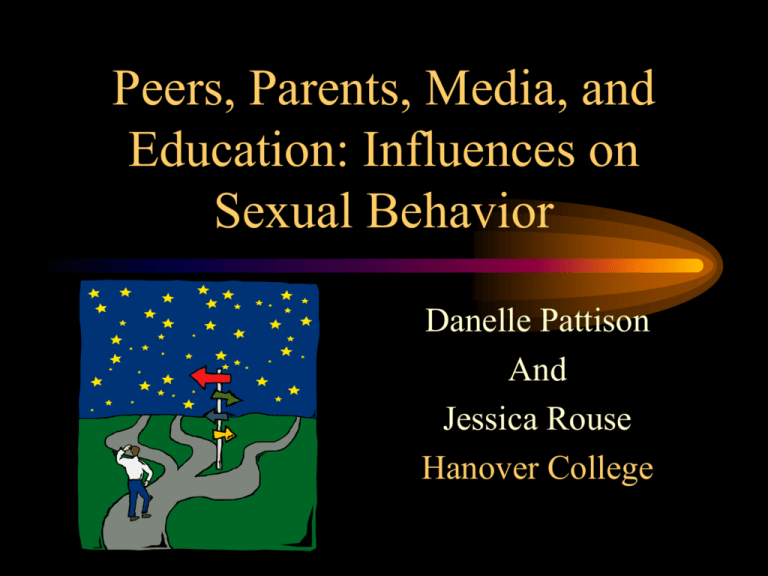
Peers, Parents, Media, and
Education: Influences on
Sexual Behavior
Danelle Pattison
And
Jessica Rouse
Hanover College
Research Objective
• The main goal of this
study is to determine the
relative contribution of
four sources of influence
on sexual behavior:
parents, peers, the
media, and sexual
education classes.
Hypothesis and Supporting
Research
• We hypothesize that peers are the driving
force in a person’s sexual decisions and have
the greatest influence on sexual behaviors.
• Peer-oriented adolescents
engage in more sexual
activities than parentoriented adolescents
(Owuamanam, 1983)
• Friends are rated highest in
shaping sexual behavior
(Kakavoulis & Forrest, 1998)
Procedure
• Created questionnaire to measure:
– Frequency of 32 sexual behaviors
– Perceived acceptance of these behaviors by
our 4 different factors:
•
•
•
•
Parents
Peers
Media
Past sex education classes
Rouse-Pattison Sexual Behavior and
Sexual Acceptance Scales
• Click on the corresponding circle that best describes the
frequency of your overall sexual behavior.
• On the scale below, please rate your perception of the
general acceptance of each behavior by clicking the
appropriate circle for each of the four different
groups.
Procedure continued
• Survey posted online
– Available through psych experiment website
– E-mailed students at Hanover and other
colleges with survey link
• 273 Internet participants, 230 sets of data
analyzed
– Dropped if data corrupted (not interpretable) or
>21 missing responses
Demographics
• 78% female, 22%
male
• Age: mean = 22
–
–
–
–
–
16-22: 80.3%
23-30: 12.2%
31-40: 5.2%
41-50: 1.7%
51-60: 0.4%
• Race
–
–
–
–
–
–
White: 88%
Black: 5%
East Asian: 3%
Latino/a: 1%
American Indian: 0.5%
Other: 3%
Frequency
Interesting Gender Differences
10
9
8
7
6
5
4
3
2
1
Masturbation
all ps < .05
Sexual
Daydreaming
Males
Vaginal Inter.
w/o Preg. Prev.
Females
Dressing
Provocatively
Preliminary Analysis
• Ran multiple regression on all 32 behaviors
separately with the four factors for each behavior
• Each Behavior = Parents + Peers + Media + Education
• Perceived acceptance of peers was significantly
positively related to frequency for all but four
sexual behaviors, which had very low variance in
frequency:
– Hugging, closed-mouth kissing, oral stimulation both
given to and received with STD protection
Frequencies
10
9
8
7
6
5
4
3
2
1
Manual Stim. Oral Given to Masturbation Inter w/ preg Inter w/o STD
Given
w/o
prev
prev
Principle Component Analysis
• Principal components analysis used to identify
“clusters” of mutually occurring behaviors
–
–
–
–
–
Fondling, 7 behaviors:
α = .95
Oral, 5 behaviors:
α = .86
Solitary, 5 behaviors:
α = .76
Inter w/ pro, 2 behaviors: α = .85
Inter w/o pro, 2 behaviors: α = .70
• Ran Linear Regression to find the impact of the 4
factors on these groups of behaviors
Standardized Regression
Coefficients (β)
Fondling
Oral
sex
Inter
Inter
Solitary
w/ pro w/o pro
Parents
.1
.0
.1
.1
.2*
Peers
.3*
.4*
.3*
.3*
.2*
Media
.0
-.1
-.1
-.1
-.2*
Sex Ed.
.1
.0
.3*
.1
.0
adj. R2
11%
11%
19%
10%
9%
•*p<.05
Possible Limitations
• Unsure about causal relationships since our
approach was correlational
– Perceived acceptance participation
– Participation perceived acceptance
• Lack of variance within demographic
variables: Age, SES, education, and race
Future Research
• Separate peer group into different factors:
Friends vs. Significant Other vs. “Peers”
• Now that we see peers are correlated with
behavior, it is important to initiate ways to
make peers the informants of appropriate
sexual education information
Behaviors with Significance other
than Peers
• Masturbation – peers, parents, sex ed.
• French-kissing – peers, media (negative), sex ed. classes
• Vaginal intercourse without pregnancy prevention – peers,
parents, media (negative)
• Vaginal intercourse without STD prevention – peers, parents
• Anal intercourse received from another person with a condom –
peers, media (negative)
• Cyber sex (talking dirty to someone online) – peers, parents,
media (negative), sex ed. classes
• Phone sex ( talking dirty to someone over the phone) – peers,
sex ed. classes
• Dressing with intent to attract sexual attention – peers, media
• Viewing pornography – peers, parents, media (negative), sex ed.
classes






